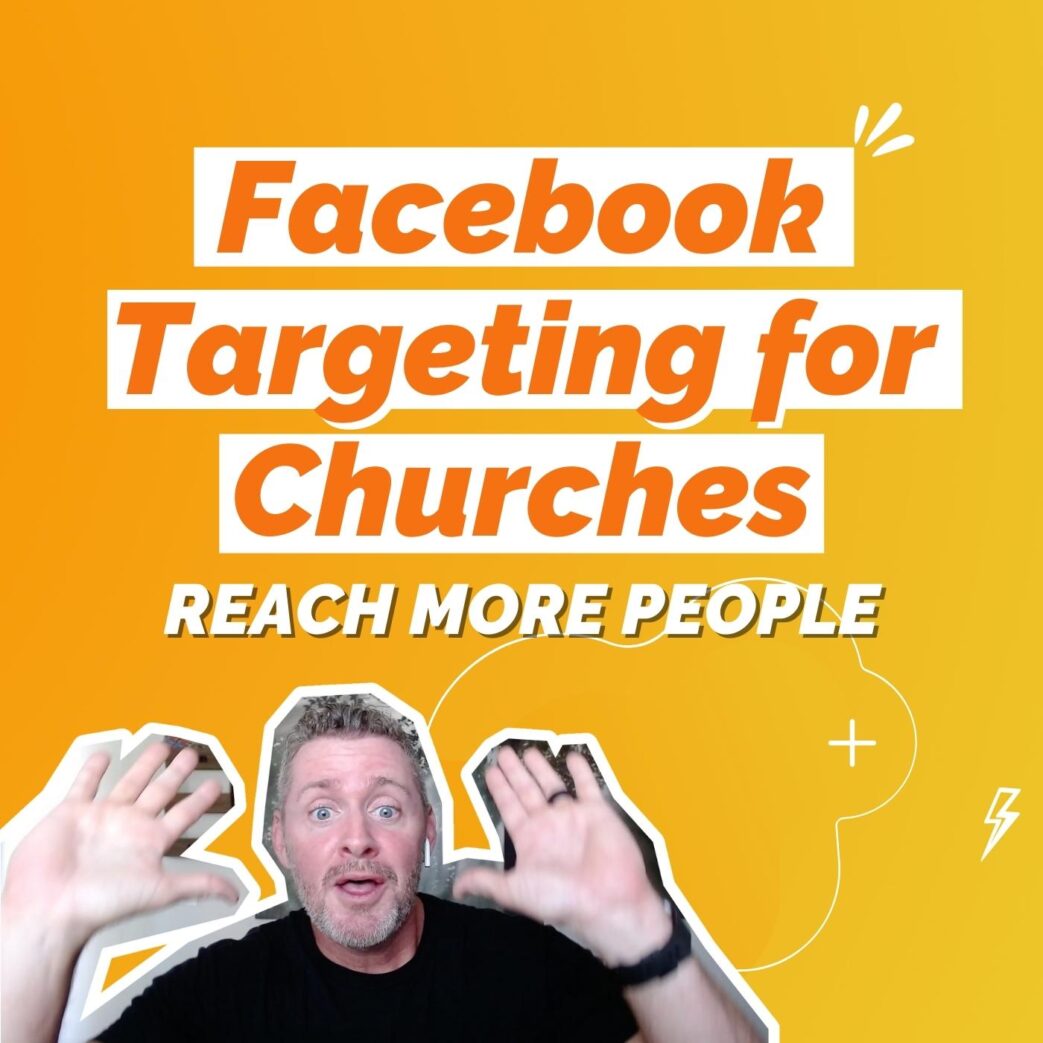Whether you personally love it or hate it, Facebook has a tremendous reach across the globe. Facebook has 2.91 billion monthly active users, and 79% of monthly users are active daily. So with all these people on the platform, how can you target the right ones as a church?
You don’t want to ignore the potential of reaching this massive audience with your message of hope. Although organic page reach is limited, you can target people through ads and see a huge return on investment.
In this podcast, we’re going to cover what you need to know about Facebook targeting for churches including the basic types of audiences and when and how to use them.
Estimated reading time: 11 minutes
Table of contents
What is Facebook Targeting for Churches?

Facebook targeting is a tool that enables your church to reach specific audiences on the platform. It involves refining outreach by demographics, geography, interests, and behaviors. This precision ensures that your church connects with the right people, optimizing their messaging and engagement for effective digital outreach.
Understanding Facebook targeting is crucial for your church’s Facebook ad campaign. Facebook’s advertising platform provides a range of tools to help churches reach their intended demographic.
Types of Facebook Targeting
There are several different types of Facebook targeting you can use in your church marketing so that your church Facebook ads reach the right audience. If you don’t want your Facebook advertising efforts to go to waste, think about how you can use these forms of targeting.
- Demographic targeting allows churches to narrow down their audience based on characteristics like age, gender, and education.
- Geographic targeting enables them to focus on people in specific locations, ensuring their message reaches the right communities.
- Interest-based targeting allows churches to connect with individuals who share similar interests or activities related to their mission.
- Behavior-based targeting tailors outreach to users’ actions on Facebook, enhancing the chances of engagement.
In simple terms, this means that churches can pinpoint who sees their content, making their efforts more effective. Whether it’s reaching out to a specific age group for a youth event or targeting residents in a particular city for a local initiative, Facebook’s targeting options provide a tailored approach.
This understanding empowers churches to optimize their communication strategy, ensuring that their message resonates with the right people.
As your church navigates this form of social media marketing, mastering the basics of Facebook targeting will become an essential tool for effective outreach and community engagement.
Why Should I Use It?

Facebook can be a great way for churches to connect with members and reach out to people in your area. You can share updates and events, as well as encourage people to join your community with a church Facebook page.
In addition, you can target specific groups of people with Facebook Ads, like mentioned in the section above. For example, you can target Facebook users who live in your geographical area or who are interested in Christian music. As a result, Facebook can be an effective way to reach out to potential new members and build your church community.
Benefits of Facebook Targeting
The benefits of targeting your Facebook ad campaign are practical and impactful. By reaching specific demographics within their congregation, churches can tailor messages to resonate with different groups, fostering a sense of connection.
This personalized approach extends to engaging potential new members or visitors, making outreach more relevant and inviting.
Promotion
Promoting events and activities to relevant audiences is another advantage. Churches can ensure that their announcements reach those most likely to be interested or affected, maximizing participation and community involvement.
This targeted communication also enhances interaction with the community, as churches can share content that speaks directly to the interests and needs of their audience.
Resource Management
Effective targeting helps churches allocate resources wisely, focusing efforts where they matter most. Instead of broadcasting messages broadly, churches can refine their outreach strategies based on data-driven insights.
This not only saves time and effort but also increases the impact of their communication.
Overall
In essence, the benefits of targeting on Facebook empower churches to build stronger connections within and beyond their community. It’s about making outreach more purposeful, ensuring that every message is relevant, and fostering meaningful engagement with the people they aim to serve. As churches embrace the opportunities offered by targeted communication, they enhance their ability to connect, communicate, and make a positive impact on the lives of those they reach.
The Different Types of Facebook Targeting Available

When it comes to Facebook targeting for churches, there are three main audience selections: core audiences, custom audiences, and lookalike audiences. Let’s talk about each of these.
Core Audiences
You can adjust the criteria for your core audience to be broad or well defined by parameters such as:
- Location: limiting the scope to your nearby geographical area
- Demographics: age, gender, job title, education, etc.
- Interests: interests, hobbies, likes
- Behaviors: prior purchases and device usage
- Connections: you can include people connected to your Facebook event or page or exclude them (if your focus is finding a new audience)
If you’re featuring online events in your ads, the location may not matter. But if you’re hosting a local event or service you definitely want to limit the geographical area to people who are within a reasonable driving distance. You also want to be careful about limiting your audience too much. Facebook typically recommends you keep your audience between 1,000 and 50,000 people.
Custom Audiences
With custom audiences, you can target people who have already interacted with your church, whether in-person or online. This can include people who have used your app.
Custom audiences can also include people who visited your website. With Meta Pixel (aka Facebook pixel) installed on your website, you can create a custom audience that is tailored specifically to your church website visitors. (Here’s how to install a Meta Pixel.)
This ensures that your ads are being seen by the people who are most likely to be interested in what you have to offer. Not only does this save you money on your ad spend, but it also helps to increase your conversion rate.
Another way to create a custom audience for Facebook targeting for churches is to upload your church’s email list from your CRM or email service provider. Facebook will then match the email addresses on your list with the corresponding Facebook accounts.
This is helpful for scenarios when you want to target your ads directly to people who are already familiar with your church.
Lookalike Audiences
Lookalike audiences are created by finding people on Facebook who share similar characteristics to your current members or those in your custom audiences.
This method is highly effective for reaching people outside of your current reach who are likely to be interested in what your church has to offer!
To create a lookalike audience, you need to have a current list of members or a custom audience. Once you have this list, you can upload it and Facebook will create an audience with similar traits and interests.
Here’s the link to the step-by-step process for creating a lookalike audience.
The Key Questions for Facebook Targeting For Churches

Knowing these audience options exist, the two main questions you need to answer before setting your ad are:
- Who are you trying to reach?
- What do you want them to do?
If you’re specific about your goals for each ad, then you can create more effective ads.
Consider the “customer journey” or funnel as it relates to your church. Generally speaking, there are people who have never heard of you before, people who may have casually interacted with your website or social media, and people who are attending your church.
If you’re trying to target people outside of your church, you may want to run an ad promoting:
- A community event such as a Fall Festival – perfect for the entire family.
- A popular holiday service such as Christmas or Easter weekend.
- A felt need such as coping with depression, anxiety, marital problems, or financial problems (that links to a landing page where you can collect their info and provide a resource).
Facebook Targeting Strategies

We all want successful Facebook ads campaigns. Hopefully, at this point, you know that Facebook targeting is the way to get there. But we want to do more than just tell you about Facebook targeting, we want to help you succeed in it.
Here’s a breakdown of practical approaches to make the most out of Facebook’s targeting tools.
Identify Your Target Audience
The first step in effective Facebook targeting for churches is to clearly define your target audience. Identify who you want to reach – their age, interests, and location. Creating detailed profiles of your desired audience helps in shaping content that speaks directly to them.
For instance, if your church is planning an event for seniors, your target audience would be older individuals, and your content should be tailored to their preferences and needs.
Utilize Custom Audiences
Take advantage of custom audiences based on your church’s existing data. Upload your contact lists to Facebook to create custom audiences. This enables you to engage with your current members in a more personalized way.
Whether you want to share updates, special messages, or event invitations, custom audiences allow you to target specific groups within your congregation.
Craft Tailored Content
Once you’ve identified your target audience, the next step is to create content that resonates with them. Tailor your messages to address their interests and needs.
For example, if you’re targeting families, share content related to family-friendly activities, parenting tips, or community events that cater to families. The key is to make your content relatable and valuable to the chosen audience.
Implement A/B Testing
You can refine your targeting strategies over time by implementing A/B testing. Experiment with different ad variations, such as images, headlines, or ad copy, to see what resonates best with your audience. Analyze the performance of these variations to understand what works and what doesn’t.
A/B testing provides valuable insights that can inform your future targeting efforts, helping you optimize your approach for better results.
Learn from Case Studies
Explore real-world examples of successful targeting strategies through case studies. Look at how other churches or organizations have navigated the digital landscape successfully. Understand their approaches, challenges faced, and the outcomes achieved.
Case studies offer practical insights into what works and can inspire adaptations for your church’s unique context.
Highlight Key Takeaways
After studying case studies, highlight key takeaways and lessons learned. Identify universal principles that contribute to success and adapt them to fit your church’s circumstances. While every context is unique, common lessons from successful cases can guide your decision-making and improve the effectiveness of your targeting strategies.
Address Challenges and Considerations
Acknowledge and address challenges and ethical considerations in your targeting strategy. Ensure that your outreach respects users’ privacy and aligns with ethical standards. It’s essential to strike a balance between promotion and authentic community engagement.
Building genuine connections with the community goes beyond broadcasting messages and requires ethical considerations at every step.
Stay Informed and Adaptable
The digital landscape evolves, and so do platforms like Facebook. Stay informed about updates, changes in algorithms, and policies. Be adaptable in adjusting your strategies accordingly.
What worked yesterday might need tweaking tomorrow, and being aware of the evolving digital environment is key to maintaining a successful online presence for your church.
Targeting for a Church Facebook Page

Churches need to be strategic about their Facebook targeting if they want to see results from their advertising spend. By understanding the options available and thinking through the key questions, you can create ads that reach the right people with the right message.
When done correctly, Facebook targeting for churches can help you to increase your reach, grow your church, and make a lasting impact in your community!
More on Social Media for Churches






Comments 1
Thank you for your insight. Been trying to figure out how to target best using facebook.